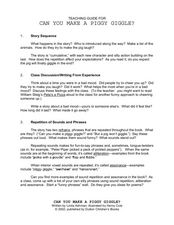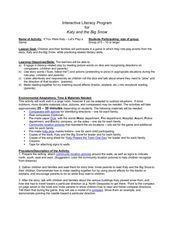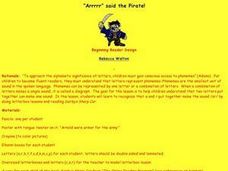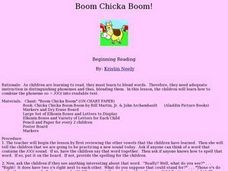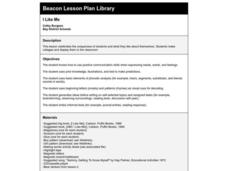Curated OER
Reading and Writing Cursive
Students dicsuss importance of neatness in cursive writing. They work with a partner practicing cursive writing. They write and answer questions using cursive writing skills.
Curated OER
Onomatopoeia
Fifth graders investigate onomatopoeia. In this reading lesson, 5th graders create a list of onomatopoeic words from books read and brainstorm words of their own in small groups.
Curated OER
Aaron's Hair
Students listen to the story Aaron's Hair. They make predictions while listening to the story. They select where the /h/ sound is heard in the pictures that represent the word.
Curated OER
The Flea's Sneeze Lesson Plan
Students read a book and engage in three different activities. In this lesson about repetitive story patterns, students read a story, The Flea's Sneeze, and examine how the story has a rhythmic pattern of rhyming verse that sounds like a...
Curated OER
Introducing Working Animals
Students identify ways humans and animals work together. In this animal welfare lesson, students read the text Hanni and Beth: Safe and Sound and define the term "working animals." Students investigate working animals by visiting various...
Curated OER
Teaching Guide: Can You Make a Piggy Giggle?
Students explore the book Can You Make a Piggy Giggle?. In this language arts lesson, students focus on a variety of aspects within the book. Students study the illustrations, listen for rhymes, and attempt the tongue twisters in the text.
Curated OER
Shaggy Sheba Shakes!
Young scholars study the /sh/ digraph in order to determine that when the letters are together in a word they make one sound. They use letter boxes, letter manipulatives with the sh taped together, and poem, "My Shaggy Dog." Using the...
Curated OER
Come On, Rain!
Students read and analyze the story. In this language arts lesson plan, students read Come on, Rain! and examine how mood and tone are created, the use of figurative language and the characteristics of the genre. Students research the...
Curated OER
Shh, Do Not Wake the Baby!
Students explore the /sh/ digraph and how it is a blending of the /s/ and /h/ sounds. They use letterbox manipulatives to spell 'sh' words and identify /sh/ words as they read a story. They 'fish' for 'sh' words to practice writing at...
Curated OER
Pop, Pop, Popcorn
Students examine the sound of the letter "P,p" and how to write it using a tongue twister. They examine how their mouths move when the make the letter sound before writing it on primary paper. While listening to a read aloud of William...
Curated OER
Thump Your Thinker
First graders discuss how t and h together make one sound and then make the sound while examining the mouth movement associated with it. They listen for the sounds in sentences that are read to them before making words with the Elkonin...
Curated OER
Using Onomatopoeia to Tell the Story of an Imaginary Field Trip
Young scholars explore language arts by utilizing word choice to compose a paragraph. In this phonetics lesson, students discuss the importance of a "voice" in their writing as they read the book Rattletrap Car. Young scholars write...
Curated OER
If You Were Katy: Let's Play a Game
Students simulate sound effects from Katy and the Big Snow. They read and discuss Katy and the Big Snow, create sound effects for the objects in the book and practice sounding out beginning sounds for words. After sounding out the words,...
Curated OER
It's Time to Open Wide for O
Students recognize the short vowel o in written and spoken language. Through listening and decoding activities, they discriminate the vowel sound /o/ from other phonemes. Students match the phoneme and letter in words they read on index...
Curated OER
Shhh Here and There
Pupils identify words containing the sh digraph in this lesson. They say a tongue twister which contains words emphasizing the sh digraph. They then read with a partner "One Fish, Two Fish, Red Fish, Blue Fish" and identify words in...
Curated OER
Poetry Immersion
Young scholars explore the genre of poetry through centers. They listen to the sound of poems being read aloud, visualize individual poems and observe and apply line breaks in poetry.
Curated OER
Quick, Quack, Quick Went The Duck
Students practice recognizing the phonemes and diagraphs in letters that blend together to form the "ck" sound. They interact with the book, "Quick, Quack, Quick!" by Marsha Arnold and the phrase, "Jack the duck found an icky sticky...
Curated OER
"Arrrrr" said the Pirate
Students practice decoding r-controlled vowels. Through various activities, they identify the change made to a vowel sound by adding "r." They decode words and spell them using Elkonin boxes. To conclude the lesson, students identify...
Curated OER
Boom Chicka Boom
Pupils recognize how vowel patterns change a short vowel sound into a long vowel sound. With an emphasis on the /oo/ that makes the long U sound, students identify the phoneme and letter combination through listening and matching...
Curated OER
Carry Your Own Load Toad!
Students explore how to spell words with the vowel digraph /oa/. They read and spell words containing the oa digraph. Students read Toad Makes a Road. They clap their hands when they hear the /O/ sound in the story. Students practice...
Curated OER
I Like Me
First graders read the book "I Like Me" and then design a collage showcasing different things they like about themselves. They write in journals to reflect on this lesson.
Curated OER
Introduce Vocabulary: Night Shift Daddy
Students explore language arts by reading a children's book in class. In this story vocabulary lesson, students read the book Night Shift Daddy and identify the use of specific vocabulary words. Students utilize the vocabulary terms to...
Curated OER
Champions of /Ch/
Students identify the digraph /ch/ in written and spoken language. Students practice identifying initial and final placement of the digraph /ch/ in words by identifying pictures containing the sound. They decode and spell words in with...
Curated OER
The Death of Old Woman Kelema
Students read various parts of "The Death of Old Woman Kelema". Next, they listen to the author's description of her writing process. In groups, they compare and contrast funerals in Mali with those in the United States. They also...







